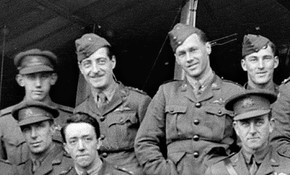
HOWARD, Richard Watson
| Service Number: | 2765 |
|---|---|
| Enlisted: | Not yet discovered |
| Last Rank: | Captain |
| Last Unit: | Australian Flying Corps (AFC) |
| Born: | North Sydney, New South Wales, Australia, November 1895 |
| Home Town: | Hamilton, Newcastle, New South Wales |
| Schooling: | Sydney University, New South Wales, Australia |
| Occupation: | Engineering student |
| Died: | Died of Wounds , France, 22 March 1918 |
| Cemetery: |
No known grave - "Known Unto God" Arras Flying Services Memorial |
| Memorials: | Arras Flying Services Memorial, Ballarat Australian Ex-Prisoners of War Memorial, Hamilton St. Peter's Anglican Church Honor Roll, Hamilton Superior Public School Roll of Honour, Hamilton War Memorial, Newcastle East Hamilton Municipal District Roll of Honor, Newcastle High School Honour Roll |
World War 1 Service
| 22 Dec 1915: | Involvement Sapper, 2765, 7th Field Company Engineers, --- :embarkation_roll: roll_number: '5' embarkation_place: Sydney embarkation_ship: HMAT Suffolk embarkation_ship_number: A23 public_note: '' | |
|---|---|---|
| 22 Dec 1915: | Embarked Sapper, 2765, 7th Field Company Engineers, HMAT Suffolk, Sydney | |
| 22 Feb 1918: | Promoted AIF WW1, Captain, No. 2 Squadron, Australian Flying Corps | |
| 22 Mar 1918: | Involvement Australian Flying Corps (AFC), --- :awm_ww1_roll_of_honour_import: awm_service_number: awm_unit: Australian Flying Corps awm_rank: Temporary Captain awm_died_date: 1918-03-22 | |
| 27 Jun 1918: | Honoured Military Cross, 'For conspicuous gallantry and devotion to duty. Whilst separated from his patrol owing to a thick mist, he drove down an enemy aeroplane out of control. He then engaged a hostile two seater which he forced to land in our lines. On another occasion though attacked at a height of 400 feet by an enemy two seater he manoeuvred, shot the observer, and caused the hostile machine to land, apparently in difficulties, but intact. He has consistently done excellent work at very low altitudes.' Source: 'Commonwealth Gazette' No. 95 |
Help us honour Richard Watson Howard's service by contributing information, stories, and images so that they can be preserved for future generations.
Add my storyBiography contributed by Stephen Brooks
Captain Richard Watson Howard was an Australian ace credited with eight victories, seven of them in a period of 3 weeks during March 1918. He was born in 1897 North Sydney; son of Frederick F. and Blanche E. Howard of Dixon Street, Hamilton, New South Wales. He enlisted in the AIF on 13 September 1915, initially with the 7th Field Company Engineers and later transferred to the Australian Flying Corps. He served with the 57th and 68th Squadrons before transferring to the 2nd Squadron.
Only 20 years of age and mentioned nine times in Official History of Australia in the War.
Military Cross (MC) Lt. Richard Watson Howard, A.F.C.
For conspicuous gallantry and devotion to duty. Whilst separated from his patrol owing to thick mist he drove down an enemy aeroplane out of control. He then engaged a hostile two-seater, which he forced to land in our lines. On another occasion, though attacked at a height of 400 feet by an enemy two-seater, he manoeuvred, shot the observer, and caused the hostile machine to land, apparently in difficulties, but intact. He has consistently done excellent work at very low altitudes.-Supplement to the London Gazette, 5 July 1918 (30780/7936)
On 22 March 1918 another patrol went out under R. W. Howard. In a general engagement at 9,000 feet, Lieutenant Rackett drove down an enemy scout north of St. Quentin, but the fight was remarkable chiefly for being the last fought by Howard , the gallant leader of the formation, who was shot down near Epehy and mortally wounded. -Extract from Cutlack, F.M. (Frederic Morley) The Australian Flying Corps in the Western and Eastern Theatres of War 1914-8, Angus and Robertson Ltd Sydney, 1941 – Page 230
On 22 March while leading a patrol of five, operating at 15,000 feet (4500 metres) Captain Howard led the formation in a dive to attack two enemy two-seaters at 10,000 feet (3000 metres) when in turn they were attacked by thirty enemy fighters and Howard was shot down.
He was initially reported missing in action, but was later reported to have died of wounds received in the above engagement on the same date. He was reported by the Germans to be buried in the military cemetery at Cambrai. However, no trace of the grave could be found by the Australian War Graves Commission, and his name was included in the memorial to the missing at the Arras Flying Services Memorial.










